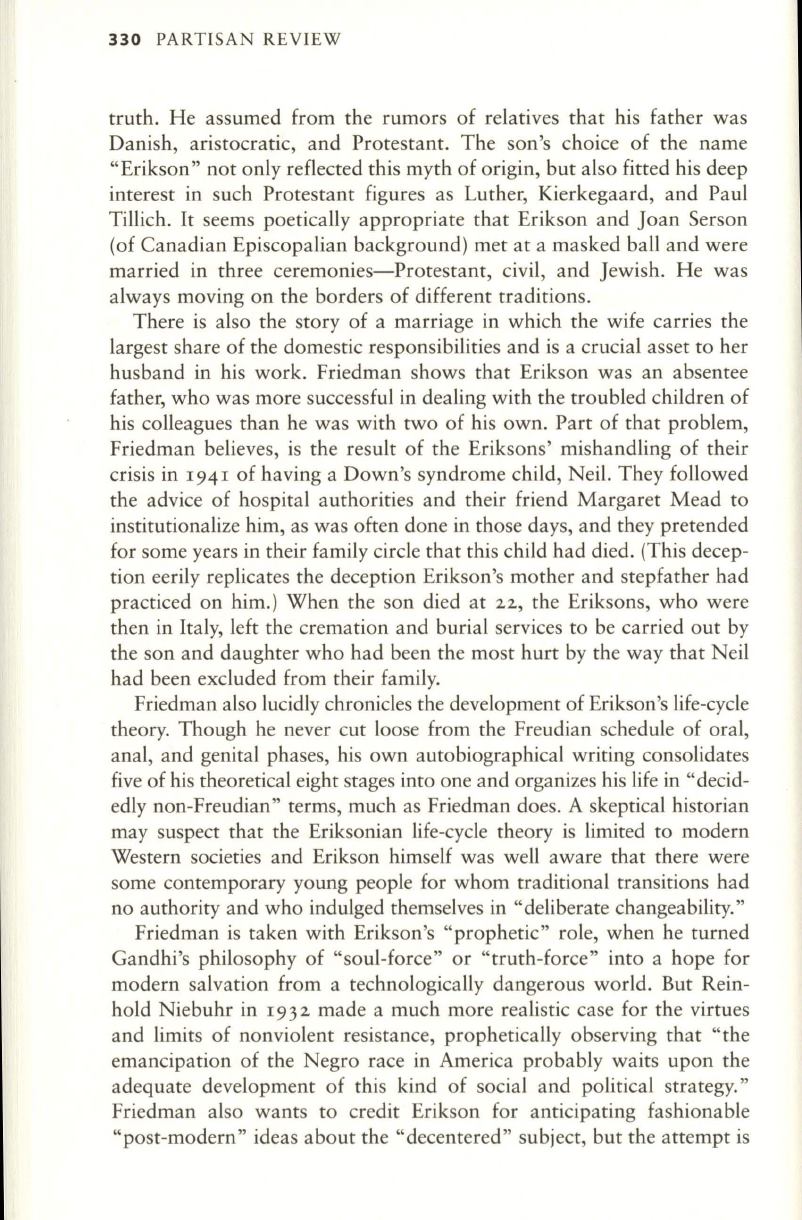
330
PARTISAN REVIEW
truth. He assumed from the rumors of relatives that his father was
Danish, aristocratic, and Protestant. The son's choice of the name
"Erikson" not only reflected this myth of origin, but also fitted his deep
interest in such Protestant figures as Luther, Kierkegaard, and Paul
Tillich.
It
seems poetically appropriate that Erikson and Joan Serson
(of Canadian Episcopalian background) met at a masked ball and were
married in three ceremonies-Protestant, civil, and Jewish. He was
always moving on the borders of different traditions.
There is also the story of a marriage in which the wife carries the
largest share of the domestic responsibilities and is a crucial asset to her
husband in his work. Friedman shows that Erikson was an absentee
father, who was more successful in dealing with the troubled children of
his colleagues than he was with two of his own. Part of that problem,
Friedman believes, is the result of the Eriksons' mishandling of their
crisis in
I94I
of having a Down's syndrome child, Neil. They followed
the advice of hospital authorities and their friend Margaret Mead to
institutionalize him, as was often done in those days, and they pretended
for some years in their family circle that this child had died. (This decep–
tion eerily replicates the deception Erikson's mother and stepfather had
practiced on him.) When the son died at
22,
the Eriksons, who were
then in Italy, left the cremation and burial services
to
be carried out by
the son and daughter who had been the most hurt by the way that Neil
had been excluded from their family.
Friedman also lucidly chronicles the development of Erikson's life-cycle
theory. Though he never cut loose from the Freudian schedule of oral,
anal, and genital phases, his own autobiographical writing consolidates
five of his theoretical eight stages into one and organizes his life in "decid–
edly non-Freudian" terms, much as Friedman does. A skeptical historian
may suspect that the Eriksonian life-cycle theory is limited to modern
Western societies and Erikson himself was well aware that there were
some contemporary young people for whom traditional transitions had
no authority and who indulged themselves in "deliberate changeability."
Friedman is taken with Erikson's "prophetic" role, when he turned
Gandhi's philosophy of "soul-force" or "truth-force" into a hope for
modern salvation from a technologically dangerous world. But Rein–
hold Niebuhr in
I 9 32
made a much more realistic case for the virtues
and limits of nonviolent resistance, prophetically observing that "the
emancipation of the Negro race in America probably waits upon the
adequate development of this kind of social and political strategy."
Friedman also wants to credit Erikson for anticipating fashionable
"post-modern" ideas about the "decentered" subject, but the attempt is


